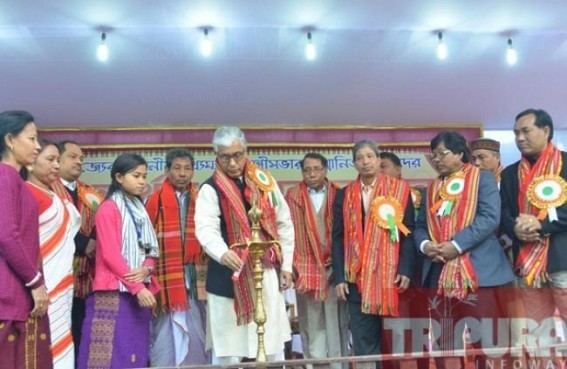 | ||
Jamatia Hoda is the institution that looks after the rights and safeguard of the culture of the Jamatia community. It has head-office in Atharobla in Udaipur town of South Tripura district of Tripura and a branch office at Khejurbagan, Agartala near Sri Krishna Mission School. It has also started a higher secondary school Garia Academy ([1]) in Atharobla (affiliated to CBSE board [2]).
Contents
- History
- Definition
- Aim and objective
- Nukhung Family
- Birth Achaimwng
- Marriage Kailaimwng
- Stages of marriage
- Divorce Kaklaimani
- Funeral
- Adoption Bwsa Pushima
- Fostering
- Puja
- Goria Puja
- References
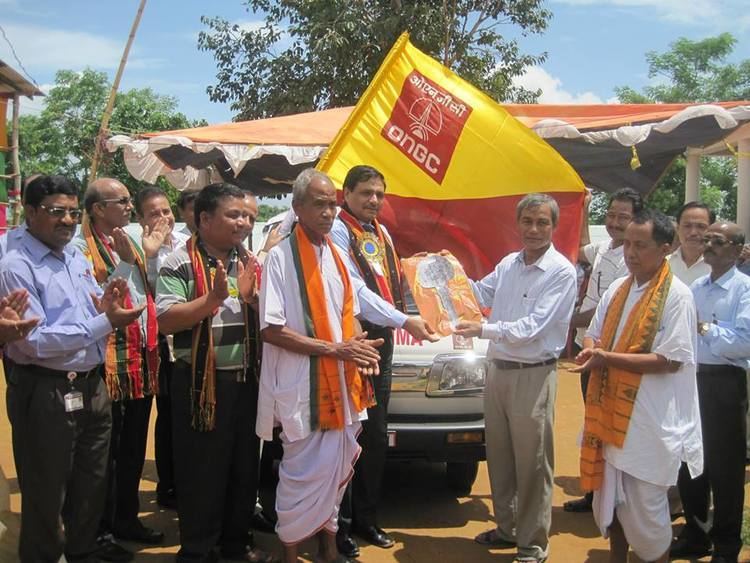
History

Tripura was once a princely State ruled by Kings and it was merged with the Union of India in 1949. There are 19 Tribes in Tripura having their separate entity with diversity, own right and they obstensively are major segments of the social fabric of Tripura with a legitimate share in the State’s unmatched pluralistic. The Jamatias are, in the numerical strength, the third among the 19 Tribes of Tripura. Today, the Jamatias are, like others of their kind, in transition, inevitably exposed, as they are, to the influences of modernity and social forces. Though, the definition of the term Jamatia is still shrouded in mystery, the history of Tripura upholds the existence of the people known as Jamatias. According to Rajmala, the Jamatias were the most important fighting tribes of Tripura during the reign of the early kings. The army constituted by them was called Jamat and from word Jamat, they later on came to be known as Jamatias. Tripura District Gazetteer records, "the term Jamatia has originated from the term Jamayet which means gathering or mobilization". According to Jamatias themselves, the word Jamatia is derived from the word Jama and Twia, Jama means Tax and Twia means not to bear the burden of. Thus the word Jamatia means a person who does not bear the burden of taxes. To some, the appellation Jamatia might have originated because of their dwelling in a congregated way (Jamayet) in a particular geographical area. According to census, population of the Jamatias is now in 2003 around one Lac. Jamatia population census is conducted by the Hoda once in every five years.
Definition
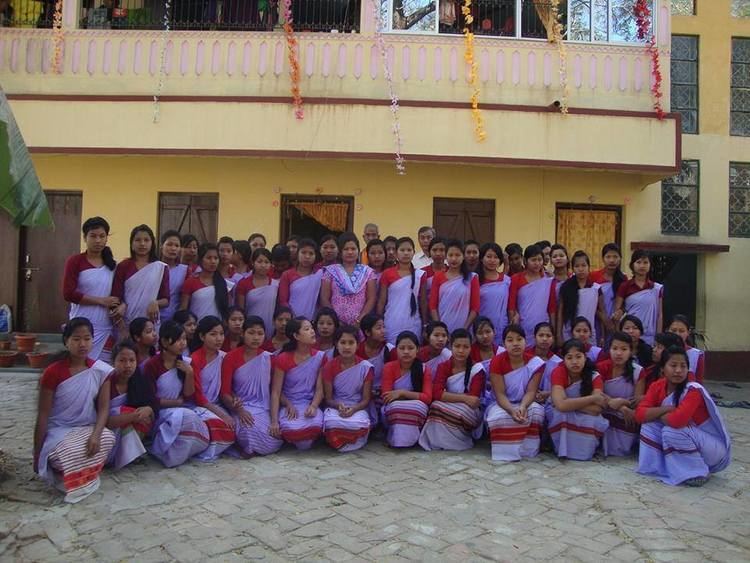
The Highest Stratum/Institution of the Jamatia Community is to be known as HODA and it is a traditional social system and hereinafter called the Highest Council in the society. The extent of this system covers only to the Jamatia Community. So, it is called as JAMATIA HODA. The Rules that regulate the Jamatia Community is called HODA RAIDA. The Jamatia Hoda is an organization, which is above the politics and solidly independent and impartial. Moial (region) & Luku (village) are the lower levels of Institute of the social organization. The ruling of the Hoda is not an object of dishonour. It is constituted to develop the character of the society as well as to make well protected the constitutional rights of India. Therefore, no individual/organisation has the right to criticize or disregard it.
Aim and objective
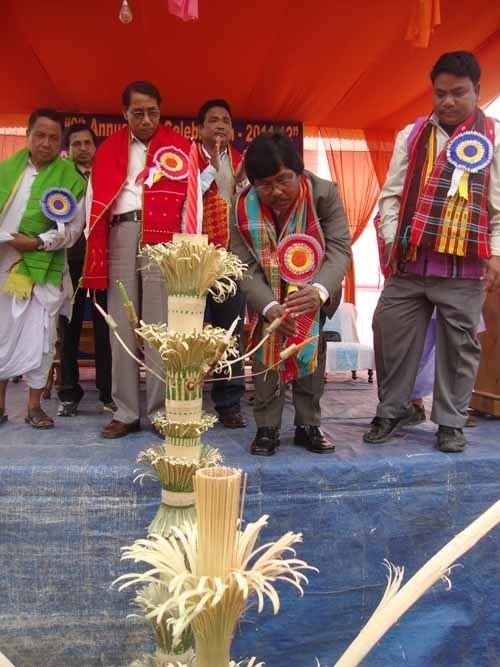
- The aims and objective of this Jamatia Hoda is to build up Social character and maintain peace and tranquility in the Society.
- The main objective of this organisation is to remove superstitions and lack of knowledge and to develop cultural activities maintaining social unity and own characteristics.
- To create public opinion against the anti-social elements and social delinquents, and to give adequate punishment to anti-socials.
- To strive for overall development of the society and showing equal social status and proper dignity to the woman are the holy objective of this social organisation.
- To show proper respect and honour to the Okras, the Supreme of the Society..
- To save and rescue the society from danger and from the hands of anti-social, conspirators and abettors.
- To show proper respect and honour to the Kherphang (Goria chief devotee), Ochai (Goria chief priest), Mwtai Balnai, Doria, Mohonto and other Jamatia Hoda Workers (Social workers).
- The main aims and objectives for which this social organisation was set up are as noted below:-
- To sacrifice and devote hard work for development and spread of education and social services for the betterment of the society.
- There is a Baba Garia Mission under the control of Jamatia Hoda, which has been working for the spread of quality education, development of cultural activities, communal harmony, national integrity, health education, peace and tranquility and development of human resources among the Jamatias in particular and people of Tripura in general.
- To encourage all Jamatia families to send their own children to school by any means for education up the age of 15 (fifteen) years.
- To encourage in the promotion of trade and industry, create awareness in sanitation and health care.
- To organize social movement unitedly to cater the requirement of the changed society and need of the hours.
Nukhung (Family)
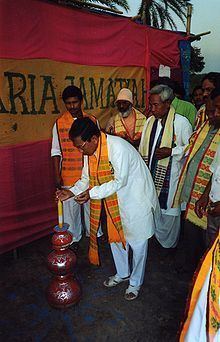
- Family, like any other human society, is the basic and universal social unit of the structure of Jamatia Community and is known as a Nukhung among the Jamatias.
- At a minimum the Jamatia family is of nuclear form consisting of husband, wife and their living off-springs, of course there may also be a family with a single member, if a male or female resides singly maintaining the elements of a family.
- A Jamatia family is based on monogamous marriage. Based on its condition i.e. residence, authority, succession and descent, a Jamatia family is a patrilocal, patriarchal, patrilineal and patronymic.
- The father or the elder male or female member, in whose name Lampra Puja is performed, is the head of the family. According to the Customs of Jamatias, the Lampra Puja is generally performed in the name of both husband and wife. His/Her decisions in all matters – domestic, religious and Socio-political is abide by all members of the family. Of course both the husband and the wife jointly share the responsibility and take decision in the matter relating to the family affairs.
- With the changes of economic life, the forms and functions of Jamatia family had undergone adaptive changes. The shifting trend from shifting cultivation to plough cultivation also changes the composition of their families. Thus, extended or joint types of families started with their burgeoning agrarian society. The transition from nuclear family based society by extended or joint type family was, in essence, a structural change due to necessity.
- A Jamatia family must be recognized by the Chokdiri of the Luku (Village). A Jamatia family must fulfill the following conditions to be recognized by the Luku Chokdiri:-
- Loyalty to the Jamatia Hoda,
- Must pay the subscription to the Luku, Moial and Hoda as prescribed by them from time to time,
- Must perform Lampra Puja at the time of opening new dwelling house and at least once in every subsequent years,
- Must worship Mailuma Puja, and
- Must worship Baba Garia, the mightiest deity of Jamatia community.
Birth (Achaimwng)
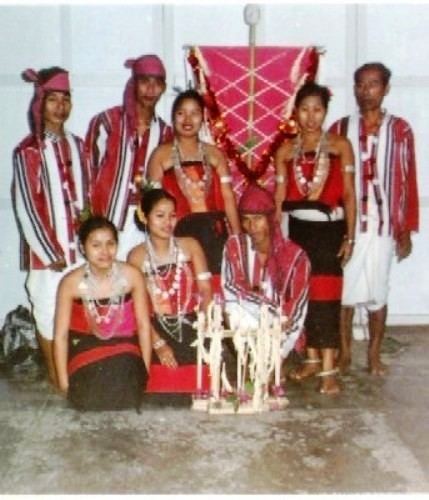
- According to the social customs, the Ochai (priest) performs a puja, called Katemwng for the welfare of the child before the birth of an expected baby.
- After the birth of a baby, Kumajwk gives a secret name to the newly born baby which is not told to anybody, and Lomajwk receives the baby and starts nursing the baby. The Kumajwk ties navel of the baby and cuts it. Till the natural fall of the baby’s navel, the Kumajwk and the Lomajwk are treated as Kunsu (unholy/unsanctity).
- After the natural fall of baby’s navel, to purify the house where the baby was born, the baby’s mother, kumajwk, lomajwk and the baby itself, an Ochai is requested to perform Lampra Puja and give name to the newly born baby.
- On the next day the Ochai performs Lampra Puja (Akatha, Bikatha, Twibuk Kalikha Raja, Sangrongma Mwtai) in the name of the newborn baby and name the baby, and announces the name given to the baby in the name giving ceremony. On the same day, the Kumajwk and the Lomajwk wearing new dresses and wrapping the baby with the new clothes they come out of the house along with the archery, who throws arrows in all possible directions, to drive out the evil spirits and the baby is shown the sun, moon, and made to touch the earth and brought back home after cleaning the feet of the baby by the mother of the baby. The Kumajwk and the Lomajwk offer all sorts of domestic equipments, cut nails and hair of the baby and offer rice (mai, chakhwi, mwkhwi, mwitru, thai-tharua, kwtwi-thalwi, anwa) to the newborn baby. In that occasion, all invitees give Ayuk bokmwng (Blessings for long life) and offer money to the newly born baby.
Marriage (Kailaimwng)
Marriage has been recognized as one of the most auspicious occasions in one’s life. Marriage is performed in accordance with the existing customs and practices of Jamatia Community.
- The priest will perform the marriage ceremony.
- The marriage ceremony is treated as a social festival / occasion by avoiding liquor as far as possible to save and except required for rituals purpose.
- The courtesy of asking the priest about the puja is called sema and for the purpose either one bottle of wine or cost of wine may be used. After the marriage only once sema is asked to the priest.
- As a mark of honour, the priest is rewarded a Dhoti and Rs. 10/- (ten).
- Invitation of priest is done by offering three beetle-nuts and leaves.
- Widow marriage is completely in practice. The marriage will be solemnized by the priest with the holy water of the Lampra puja.
- Marriage is solemnised by the Ochai (community priest) in which a bridegroom and a bride are united by the blessings of their parents and elders, sprinkling holy water of Chaudda Devta (14 God and Goddesses) over the heads of the bride and bridegroom.
- While solemnising the marriage ceremony Ochai worships Chaudda Devta puja and make them offer pranams to chaudda Devta before they are taken to the Haya (A Holy Altar). The bride and bridegrooms are purified by taking bath with holy water collected by Ayas. After being blessed by sprinkling water the bride and bridegrooms are taken to the Benky (A protected and secret room of Bride and bridegroom) and their fortune is tested allowing the bride & bridegroom to search Rangkwchak (Gold) & Rukphai (Silver) in a holy pot full of water in blind method. Thereafter, they change their dress and take food after one day fasting.
- Jamatia Community is a monogamy society. Polygamy is strictly restricted in Jamatia Community. In Jamatia Community arranged marriages are popular and betrothal (engagement) is arranged two/three months before marriage ceremony is performed. Marriage ceremony is performed generally in the month of Agrahayan and Magh. Marriage is not performed in the month of Badra, Push and Chaitra and in the birth month of the bridegroom. The engagement of the marriage must be informed to the Luku Chokdiri.
- It is the responsibility of the bridegroom’s parents to bring the bride in a befitting manner but it is not so with the brides parents. Either bride can go to the house of bridegroom or bridegroom can go to the house of bride. It is decided on the basis of negotiation.
- Marriage by Service in the house of in-laws is gradually diminishing.
- Elopement marriage exists but discouraged and not well accepted in the Jamatia Community.
- Widow, Widower or divorcees are permitted for remarriage. But during this remarriage the male is only socially permitted to avail holy Haya for marriage ceremony if the male weds with a virgin lady but in no way widow/divorced woman is socially permitted to avail holy Haya even if she marriages with a bachelor.
- The age difference for marriage between male and female should not be more than 15 years.
- The minimum age for valid marriage is 22 years for male and 18 years for female.
- In violation of this age limit, the marrying parties are given pecuniary and physical punishment.
- Dowry system is completely prohibited in Jamatia Community.
- In Jamatia Community there cannot be marriage within third generation.
- Extra-marital relations are strictly forbidden in Jamatia Community and for the cases of adultery punishment is inflicted by the Luku, Moial and Hoda considering the gravity of offence.
Stages of marriage
- Lampra Puja is performed in the name of supposed to be bride or bridegroom in shukla paksha.
- Negotiation starts headed by respectable person having spouse living.
- Formal declaration of engagement of marriage and intimation to Luku Chokdiri along with small entertainment offered to respectable members of the village after engagement is agreed upon. The expenditure is to be borne by a party proposing the marriage.
- After returning to the village another formal declaration is to be announced in a small party arranged by the proposer in his house where Chokdiri and other respectable persons will be invited and in that party a representative from other party (bride or bridegroom) will also be present. The expenditure will be borne by the party who has initiated negotiation and returned with engagement.
- Chok Khanmani (offering drinks):- According to the customs of Jamatias the proposer will offer drinks in the honour of the parents, relatives and villagers of the agreed party at least two times and date of marriage ceremony is fixed in that occasion.
- Hanjwk Nahomani (fetching the bride) or Chamwrwi thangmani:- Bride is fetched by the party of bridegroom with honour and bridegroom goes to the house of bride on his own with his associates.
- Marriage ceremony:-
- Construction of Haya (Holy Altar).
- Mailuma & Khuluma puja inside Benky.
- Chaudda Devta puja.
- Haya Gurimani:- Bride & bridegroom jointly 3 times and bride singly 4 times.
- Haya tisamani (bride & bridegroom).
- Twilumani:- Sprinkling of holy water by the Ochai first then parents & elders having spouse living.
- Rang kwchak rukphai khonokmani,
- Haya puja,
- Sabda Sema naimani,
- Benky chati sokmani,
- Ri sumani tei khorok motom sumani,
- Twi mwtai / Twi swkal no romani.
Divorce (Kaklaimani)
- The concept of divorce is prevailing in Jamatia Community and it is permissible. In case of any dispute between husband and wife, the kins try to resolve in a peaceful manner. If they fail to settle, the Luku Chokdiri intervenes and try to settle the dispute. If the Luku Chokdiri fails to settle at his level then the divorce case is referred to the Moial Panchai.
- As the Hoda is the Supreme Council and the Sole Authority for decision of divorce case, the Moial Panchai cannot decide the divorce case without being authorized by the Hoda Okra.
- The Hoda Okra empowers the Moial Panchai for deciding the divorce case for one year. Being empowered the Moial Panchai summons both the parties and hear them. After hearing them the Moial Panchai passes judgement either dissolving the marriage or settling the disputes.
- If Moial Panchai also fails to settle the case, he refers the case to the Hoda Okra and final order is passed by the Hoda Okra.
- If one party is found highly prejudiced or aggrieved, the aggrieved party can approach the Hoda Okra for review. In that case Hoda Okra can review the decided case in presence of members of the Advisory Board and Working Committee.
- There may be many grounds leading to divorce. Some of the important or common grounds may be cited as follows:- Maladjustment, desertion, unfaithfulness, adultery, physical and mental cruelty, venereal disease and disclosure of the fact that the wife has already conceived with another man prior to marriage. The case of divorce may be instituted from either side.
Funeral
- According to the Jamatia customary laws the death is regarded into two types: -
- Natural death
- Unnatural death. In case of any death, all the Luku families and relatives are informed.
- After arrival of all relatives, warm water is made and the dead body is bathed and dressed with new clothes, ri-khorok, garlanded and placed on Talai and decorated and Maikhlai (Meal) is offered bided farewell by all present.
- The dead body is lifted by the Santais and seven rounds are made and all offspring of the deceased are made to roll on the ground and the body is taken to the Simalwng (cremation place) with Sangta.
- According to the Jamatia customs, the dead body is placed keeping head towards north side; all descents present go round the dead body from the left side, cross the fire among the descents and sons of the deceased and burnt.
- After burning, while leaving the funeral place, Simalwng Noksa (small hut for the rest of the departed soul) is made, one flag is put, knots are made by all the participants, they take bath and return to the house of the deceased person.
- On the next day, bones are collected by the selected persons by the Luku Chokdiri, put in the bamboo pipe and brought to the house of the deceased and kept in the bamboo made Kwthwi Khanplai (place where bones are kept).
- The funeral ceremony is celebrated, in case of death of a major male, after 12 (twelve) days and 12 nights of death i.e. on the 13th day and in case of death of minor male or female, the funeral function is celebrated after 3 (three) days and 3 nights of death i.e. on the 4th day.
- The relatives, in case of 'Santais' 12 days and in case of relatives from female’s side 3 days take complete vegetarian during the days between the death and celebration of funeral function. The son (s) of the deceased person take vegetarian for 13 days.
- According to the customs of Jamatias, in case of un-natural death, the funeral ceremony is not performed and no relative takes vegetarian. But the guardian of the deceased person gives feast in the name of deceased person on the auspicious day.
- The Ochai, the community priest, performs funeral ceremony.
- Not like the earlier days, now "Dan/Dakshina" (donation) of land, cow and rice in funeral function is prohibited. The "Sulo Bidhi-Sulo Dan" (donation) has to be given to Ochai for performing funeral ceremony of worth Rs. 40/- and Ochai Sema (Dhakshina) of Rs.10/- (Total rupees fifty) only.
- In Jamatia Community, death anniversary is strictly observed. The Bhuisu Maikhlai (Offering of Lunch to the departed soul) is also observed, preceded by Mai Tokha (Offering of Breakfast to the departed soul) among the Jamatias on the day of Hari Buishu i.e. on the 2nd last day of the year. This is ended with the Lampra Puja performed by the Ochai followed by the community feast.
Adoption (Bwsa Pushima)
- In Jamatia Community adoption may be categorized in two types:- one is adoption for barrenness and other one is adoption as Son / Daughter of Dhormo, known as Dhormoni Bwsa, even having their own offsprings. Both the systems of adoption are permissible in Jamatia Community.
- In Jamatia Community adoption is made through performing social rituals. Even there is no caste bar for adoption of a child. The adoptees by the barren parents acquire the rights of any legitimate sons or daughters.
- In case of adoptees by the parents having their own offsprings, their rights depend upon the understanding with other off springs the adopters.
- As such there is no hard and fast rules regarding distribution of land or property to the adopted sons and daughters.
- The distribution of land or property to the adopted sons and daughters mostly depends upon the understanding between the adopters and adopted children.
Fostering
- Fostering is prevalent in Jamatia Community. If the mother of a child dies or is unable to suckle the child, arrangements are made for suckling and upbringing of the child by another woman who is capable of doing so.
- The foster-mother is selected from the matri-clan. A foster-mother is normally a related sister of the child’s mother.
- There is no hard and fast rule as to how long and to what extent the foster parents are to remain responsible socially and economically for the welfare of the child. In no case, a foster child can claim or inherit any property from the foster parents.
Puja
- Conventionally, the pujas and important festivals are performed by the Hoda in every year. These are:-
- Ganga puja,
- Goria puja,
- Bolong Suwamani and
- Lakshmi puja.
- Every puja is offered in the name of Okra.
- Every representative has to pay delegate fee of Rs. 5/- (Rupees five) only for each puja or festival.
- Gonga puja is worshiped in the Twima, Kosoma, and Burima Rivers.
- The main objective of holding puja to different Gods and Goddesses is for the welfare of the society and family. These are Lampra, Mailuma, Khuluma, Nakri, Ker puja etc. All the above mentioned pujas are performed by the Ochai (the community priest).
Goria Puja
(1) The Baba Goria is the universal God of all indigenous Tripuris. Goria festival is observed for seven days commencing from last day of Chaitra proceeded by Hari Buisu. The first day of the puja is called Moha Buisu and the day of immersion is called Sena. The articles that are essential during the puja are kept in lock strictly in the house of Kherphang as per the rule of the Goria puja.
As a mark of beginning of Goria puja Chukbar is made strictly before the Goria puja that is seven days before the puja is due. That day the articles that were kept in lock during one year are brought out and immediately the sound of drum is made by beating as a mark of beginning puja followed by playing of flute. In the Jamatia Community, Goria puja is observed in two places with full enthusiasm-
The society/institute regulates the rules of the Goria puja.
(2) A group of Bogla is selected to help the pilgrims in their troubles during the period of seven days.
(3) A Mohanta is selected by the Hoda to monitor and guide the Bogla in accordance with the resolution adopted by the Hoda and as per traditional rites.
(4) Two Goria volunteers from each region are selected in every year for maintaining discipline and peace during the Goria puja.
'Baba Garia
